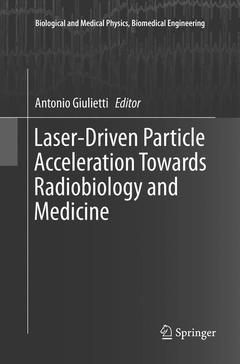Description
Laser-Driven Particle Acceleration Towards Radiobiology and Medicine, Softcover reprint of the original 1st ed. 2016
Biological and Medical Physics, Biomedical Engineering Series
Coordinator: Giulietti Antonio
Language: English
Subject for Laser-Driven Particle Acceleration Towards Radiobiology...:
Keywords
Innovative Radiotherapy; Laser-Driven Particle Acceleration; Laser-Plasma Interactions; Multi-Gev Laser-Wakefield Accelerator; Protontherapy of Cancer; Radiobiological Tests; Spatio-Temporal Radiation Biophysics; Stable Production of Ultrashort Relativistic Electron Bunches; Synchrotron Source Pre-Clinical Trials; Ultrafast X-Ray Imaging of Living Cells
Publication date: 05-2018
Support: Print on demand
Publication date: 05-2016
Support: Print on demand
Description
/li>Contents
/li>Biography
/li>Comment
/li>
Antonio Giulietti is a physicist operating at INO (National Institute of Optics, Italy). He has been CNR Research Director and Head of the Unit "Adriano Gozzini" of INO. He founded ILIL (Intense Laser Irradiation Laboratory) in the CNR Campus of Pisa which has been operating for more than 20 years with scientific output and international collaboration making ILIL a primary reference in the domain of laser-plasmas. AG is author of more than 200 papers published on international refereed journals, mainly in the field of laser and plasma physics, plasma instabilities relevant to Inertial Fusion, radiation from plasmas, laser-driven particle acceleration and their biomedical potential. AG has organized and chaired a large number of international conferences on these topics. He is member of the International Advisory Board of the International Conference on High Energy Density Science, annually held in Yokohama. His research group has been supported by CNR, Italian Ministry of Education, Italian Ministry of Health, European Union, Extreme light Infrastructure (ELI), CEA (France), JSPS (Japan). AG has been very active in teaching and tutoring students and young scientists. Young scientists trained in the AG' lab are today Professors or Researchers in prestigious Universities or Research Institutions, including Universities of Pisa, Siena, Milano, Bordeaux, Oxford, Belfast, Ecole Polytechnique in Palaiseau, CEA-Saclay, BMI-Berlin, Rutherford Appleton Laboratory. In the last ten years 2006-2015 AG devoted most of his work at studying possible medical uses of laser-driven particle accelerators. Experiments performed in Pisa and at CEA-Saclay led to the discovery of a high efficiency acceleration regime allowing the production of electron bunches whose charge and kinetic energy are suitable for radiotherapy. Those electrons were also used to drive a gamma sources and produce photo-activation, so opening a perspective of interest for nuclear medicine. In the me
Provides a new method for radiation therapy of cancer
Explains laser-driven acceleration of particles
Presents spatio-temporal radiation biophysics
Opens a new field of medical physics
Includes supplementary material: sn.pub/extras



